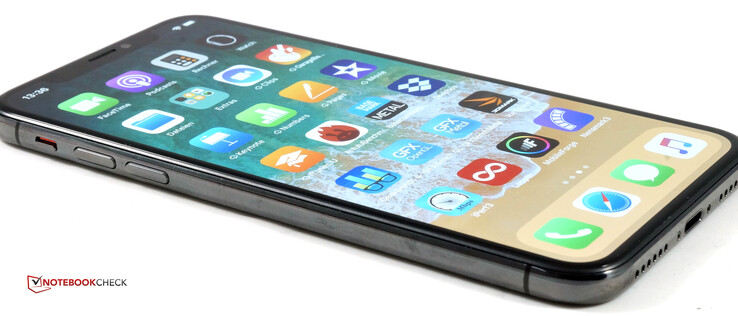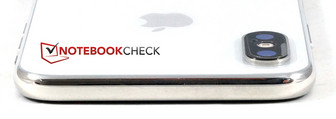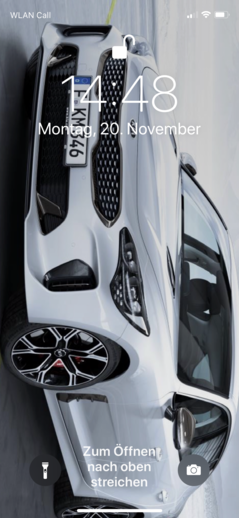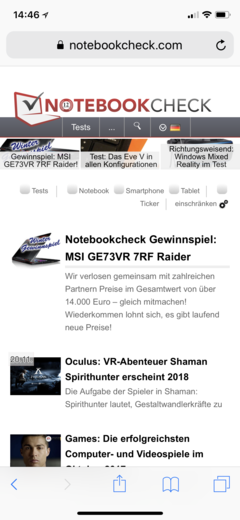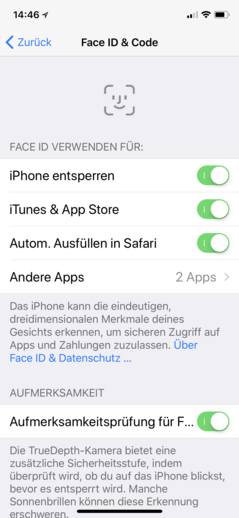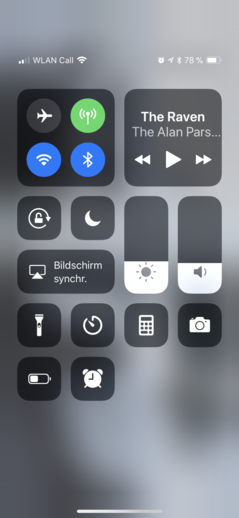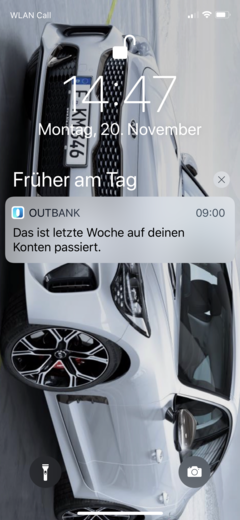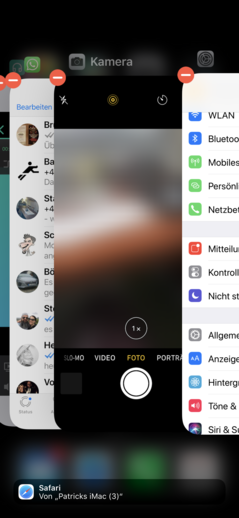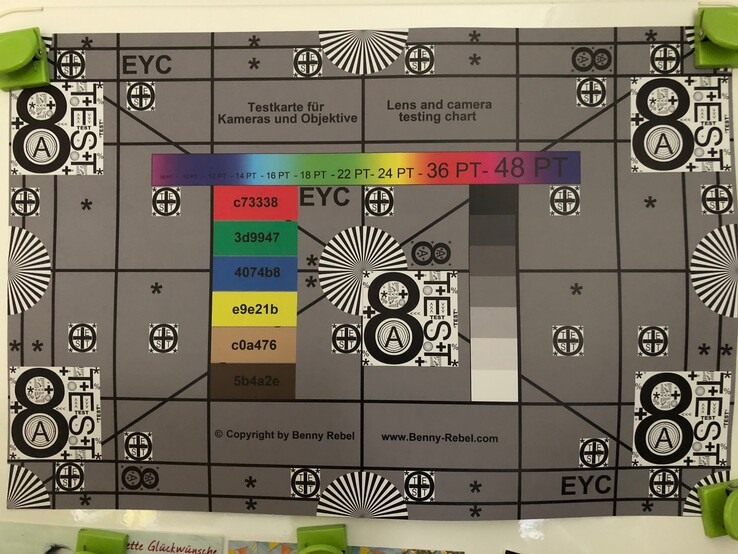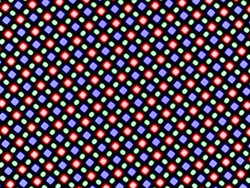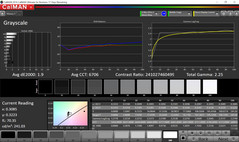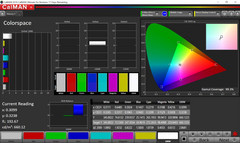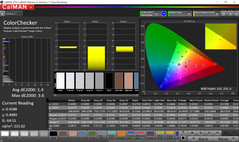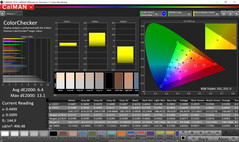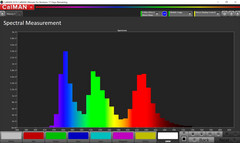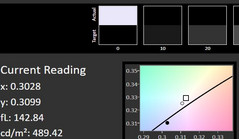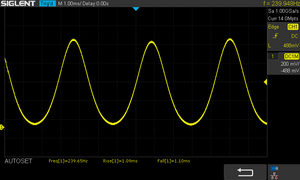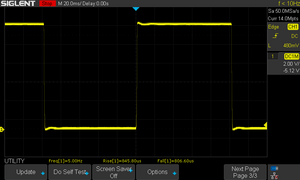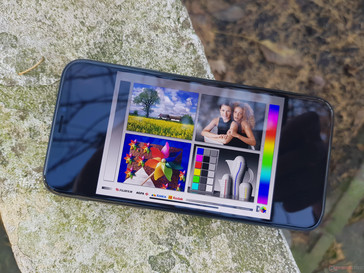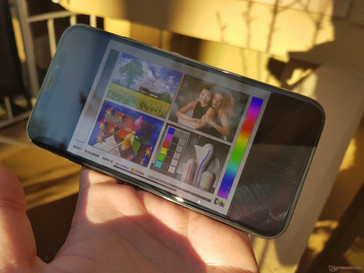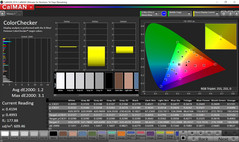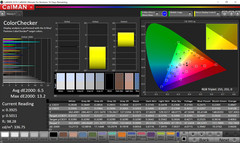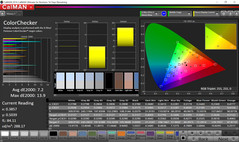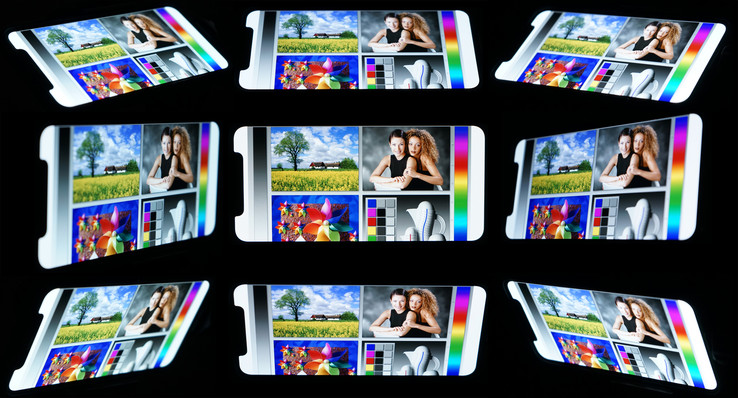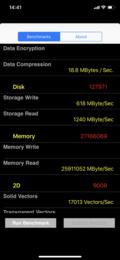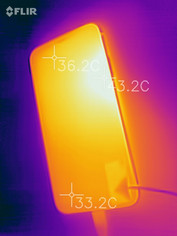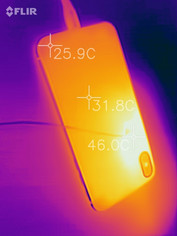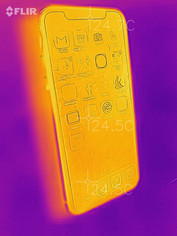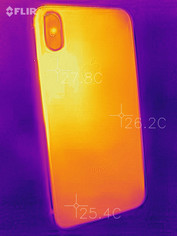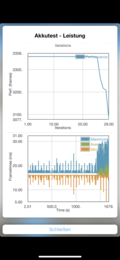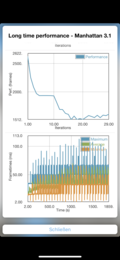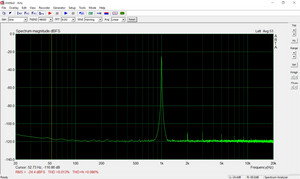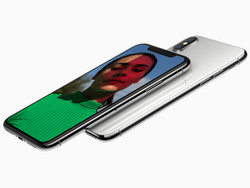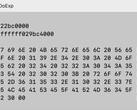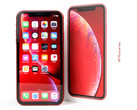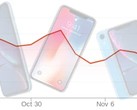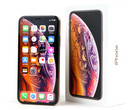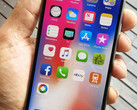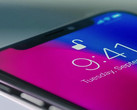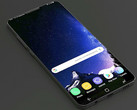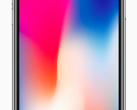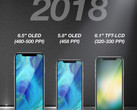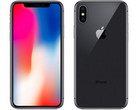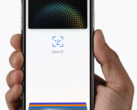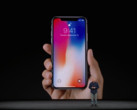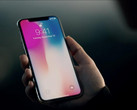Apple iPhone X Smartphone Review
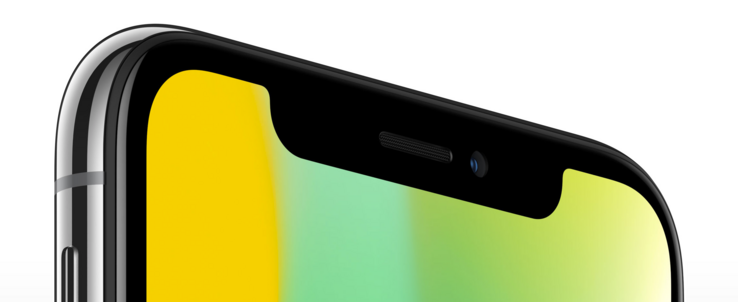
For the original German review, see here.
We already knew that Apple would show something special for the 10th birthday of the iPhone. There have been multiple leaks ahead of the announcement, so the iPhone X (pronounced "iPhone 10") was not a big surprise. The two regular models iPhone 8 as well as the iPhone 8 Plus were launched a few weeks ago, and now you can also get the anniversary model. We ordered both color and storage variants from the Apple store and will check them thoroughly.
The highlight of the new iPhone X is obviously the screen. While the regular iPhone 8 models continue the design of the recent years (included thick bezels), the front of the new model is now almost completely made of glass. However, we have already seen the trend towards slimmer bezels on many other smartphones this year. There has also been some criticism about the notch for the sensors and the front camera immediately after the announcement, because it occupies some screen space. We will obviously check how this affects different apps and how the first OLED screen on an iPhone compares against previous LC displays.
There is another big topic related to the new screen, because there is no more room for the Home button with the integrated Touch ID fingerprint scanner. Instead, the manufacturer from Cupertino now uses facial recognition called Face ID. After problems with this method on the Samsung Galaxy S8, we are curious to see how the technology works on Apple's smartphone.
The performance center called Apple A11 Bionic is already familiar from the other two iPhone 8 models, but we are not disappointed thanks to the enormous performance. The anniversary model still has advantages in terms of camera equipment and charging technology, because both sensors support optical image stabilization. Thanks to the new case with the glass rear panel, the iPhone X can be charged wirelessly. Fortunately, Apple uses the popular Qi standard, so you can use many popular charging products.
All of this naturally comes at a price. The small 64 GB SKU retails for 1149 Euros ($999); the bigger 256 GB model for 1319 Euros ($1149). You should also consider purchasing Apple Care+ for 229 Euros ($199) after the announcement of horrendous repair costs.
Case
The most noticeable parts of the case of the iPhone X are the ones missing compared to previous generations. Apple has removed the Home button including fingerprint scanner. The wide bezels at the top and bottom of the screen are mostly gone as well, so the anniversary iPhone finally has a decent screen-to-body ratio. 81.14% is a very good result, but still falls behind other smartphones. The Samsung Galaxy Note 8, for example, manages more than 83%. The Essential Phone is at the top of this list at almost 85%. For comparison: The Apple iPhone 8 only manages meager 65.6%, even though its case is just a bit smaller than the X.
Which brings us to the dimensions. In terms of size, the iPhone X is sitting between the regular iPhone 8 and iPhone 8 Plus. It has the biggest screen size at 5.8 inches, but the chassis is more compact compared to the 16:9 display of the iPhone 8 Plus thanks to slimmer bezels and the 2:1 aspect ratio in particular. The X measures 143.6 x 70.9 millimeters (~5.7 x ~2.8 in) with a height of 7.7 millimeters (~0.3 in). However, you must not forget the camera bump. It is pretty visible with both sensors and the flash. It is not implemented horizontally, but vertically. This is not as noticeable on the dark model, but a bigger issue on the white SKU. Compared to the iPhone 8, the X is 5.2 millimeters (~0.2 in) longer, 3.6 millimeters (~0.14 in) wider, and 0.4 millimeters (~0.01 in) thicker. The difference is similar to a slim silicone case. This is a good way to imagine the size difference: The "naked" iPhone X is about the size of the iPhone 8 with a silicone case. The additional weight of 26 grams (~0.9 oz; 174 grams/~6.1 in) compared to the iPhone 8 is definitely noticeable when you hold it in the hand, but the 8 Plus is still the heaviest smartphone from Apple.
Apple has already returned to rear glass panels for the iPhone 8 models – thanks to the Qi standard. Wireless charging also works on the iPhone X, so it has a glass rear panel as well. The color choice is limited to Space Grey and Silver this time. The dark model is surrounded by a black metal frame; the Silver model by a chrome frame. The rear panel of the Space Grey model actually looks like very dark glass, whereas the silver one looks like it has a matte white or light gray rear panel.
This does not change the choice of materials and the build quality, which is once again excellent. The X leaves a sophisticated impression, has no gaps or protruding edges, and is also very torsion-resistant. A slightly thicker smartphone does not only have disadvantages after all. Apple has also managed to create a very good transition between the surrounding metal frame and the glass panels at the front and rear. Sensitive users will still feel a slightly rough edge. The SIM tray on our test model did not fit perfectly either, unlike the implementation of the case buttons, which are conveniently sized, feature a perfect pressure point, and are well integrated. The power button is much bigger compared to the iPhone 8 models, most probably because it has got additional functions after the removal of the Home button.
Apple has not changed the protection against water and dust; the iPhone X is also certified according to IP67. The same limitations apply as well: The water temperature has to be "normal", and a wet device must not be charged.
Connectivity
Apple calls its anniversary smartphone the 10th iPhone generation, but it shares most of its connectivity features with the iPhone 8 models that have been available for about two months. This is especially true for the technology with the latest Apple chip called, which we will test in the Performance section. As with the iPhone 8 Plus, Apple has equipped the X with 3 GB of RAM, only the smaller sibling iPhone 8 is limited to 2 GB.
The port situation is quickly covered for Apple smartphones nowadays. Since the iPhone 7 generation you only get the Lightning port at the bottom. It is used for charging, to attach headsets, and to transfer files. Apple still uses USB 2.0 for the iPhone X so many users will probably switch to wireless data transfers. You also get NFC, barometer, 3-axis gyroscope, accelerometer, proximity sensor, and ambient light sensor.
The facial recognition, Face ID is new compared to the iPhone 8 and iPhone 8 Plus. It uses a new front camera called TrueDepth with multiple sensors, but we will talk about it later in the review.
Software
iOS 11 was introduced with the iPhone 8 models and is obviously the operating system for the X as well. However, Apple has already launched several smaller updates, so the current version is 11.1.2. The optional fast-charging is also available by now, and Apple has fixed some problems with the battery runtime and the stability of the Bluetooth connection. It appears as if Apple has simply removed the Beta status of iOS 11 with the last update. Our test sample ran very well, and hardly anything has changed about iOS 11 since our reviews of the iPhone 8 models. Users of the iPhone still have to get used to some new things. We will talk more about that and the main new feature, Face ID, below. All other information about iOS 11 is available in our reviews of the iPhone 8 and 8 Plus.
The Home button is gone, and with it the corresponding actions as well as the fingerprint scanner, Touch ID. Let us start with the latter. After we used the iPhone X for a few days, we do not miss Touch ID. The facial recognition, Face ID works so reliably that you almost forget the fingerprint scanner. Almost, because you have to put your face in front or above the display. This does not make it easier when the iPhone is sitting on a table. Otherwise, the recognition also works from an angle. The typical looking down position on the couch is no problem for the sensor, the same as hats, glasses, or a changing beard. This changes however when the face is partly covered or when you pull faces. The unlocking process usually happens without a delay, but it often takes one or two seconds longer in the dark. It is still reliable most of the time. This is, however, anything but a long-term study, and not all colleagues had the same good experiences. Subjectively, however, Face ID is faster and more reliable compared to Touch ID.
Despite all of this, the Home button is still gone. Apple has removed the swipe gesture to unlock the smartphone with iOS 10, so what happens on the iPhone X? Correct, a swipe gesture. But Apple does not return to the old and proven stuff. Instead of a gesture from left to right, you now have to swipe from the bottom to the top. You get used to it very quickly, since this is a common gesture for the control of the iPhone X. Returning to the Home screen works like this as well. If you keep your finger on the display after the gesture, you will enter the App switcher. Another long push on the app lets you stop the app via symbol, even though the familiar swipe to the top still works. You will also have to learn new commands for screenshots (now Power + Volume up), turning the device off (Power + Volume down) as well as other things such as zoom. Instead of three taps on the power button, you now have to push the power button (which is now called side button).
The notification center is now hidden in the upper left corner and can no longer be accessed from the entire top edge. There are two reasons: First, there is the notch in the top center and secondly, the control center is now accessed from the top right corner.
Communication and GPS
As with the iPhone 8 models, the anniversary model is also equipped with modern communication modules. This includes fast Gigabit LTE – probably Cat. 16 – with numerous LTE bands, just like the WLAN standard 802.11ac with support for 2.4 and 5 GHz networks. Thanks to the MIMO technology, the WLAN module can reach more than 1 Gbps in theory, but the practical values are obviously lower. Here we can see similar results to the regular iPhone 8 models: The iPhone X manages a new record of 939 Mbps in combination with our reference router Linksys EA8500 when it receives data. It even beats the previous record result of the iPhone 8, but the iPhone X cannot beat its siblings when it acts as a server. 456 Mbps is still a respectable result, but only average in comparison. Both the range and the stability of the connection are very good.
The iPhone X is also up to date when it comes to near field communication. Bluetooth 5.0 is still reserved for a handful of smartphones, but the X still cannot drive more than one audio component, unlike the Samsung Galaxy S8+, for example. NFC with typical Apple restrictions is included as well.
| Networking | |
| iperf3 transmit AX12 | |
| Samsung Galaxy S8 | |
| Huawei Mate 10 Pro | |
| Huawei Mate 10 Pro | |
| Sony Xperia XZ1 | |
| Apple iPhone X | |
| Apple iPhone 8 Plus | |
| iperf3 receive AX12 | |
| Apple iPhone X | |
| Apple iPhone 8 Plus | |
| Sony Xperia XZ1 | |
| Huawei Mate 10 Pro | |
| Huawei Mate 10 Pro | |
| Samsung Galaxy S8 | |
Almost all Apple smartphones in the past have been very convincing navigation devices. Only the iPhone 7 struggled a bit with extremely bad weather, which was visible in the recorded track data. The situation was much better for the iPhone X. The sky was cloudy, but it was not too bad. But first things first: The initial satellite fix takes only a few seconds on the anniversary iPhone. The connection even works indoors as long as you are not too far away from a window. We also took a small MTB tour to check the practical capabilities and compare the results with the special navigation device Garmin Edge 500. We use the MTB app from Runtastic to track our bike ride.
The iPhone X performs very much like its siblings 8 and 8 Plus. This is not surprising, since the specifications are identical. The new iPhone even records a slightly longer track compared to the Garmin Edge 500, and there are no unnecessary additions. The quality of the recording is just higher or it includes more waypoints. The accuracy of the track, however, is better on the specialized device. The iPhone often puts us slightly next to the actual track, and it looks as if we fly across the water instead of taking the bridge. All in all, the iPhone X still works very well as a navigation device, both on and off the road.
Telephone Functions and Voice Quality
We were not fully convinced by the voice and sound quality during calls of the previous two iPhone generations. Voices sounded rather tinny, especially in 3G networks. There were also occasional dropouts. The iPhone X shows the same behavior, but not as pronounced. There is absolutely no criticism for the quality at the earpiece when you make calls via LTE or WLAN. Quite the opposite: The quality on our side is excellent. The recipient also confirms that the ambient noise suppression works well. Only the wind is a challenge for the iPhone X, because the system will sometimes filter full words. It was admittedly very windy though. Once again, the performance of the speaker during calls is an issue. Voices do not sound as tinny as on the iPhone 8 models, but the constant background noise was also a problem on the iPhone X.
Cameras
The specifications of the 7 MP camera at the front of the Apple iPhone X are similar to those of the iPhone 8 and iPhone 8 Plus. It features an f/2.2 aperture, automatic HDR mode, electronic image stabilization, 1080p video, and all the other things we know from the previous models. Unlike the current iPhone 8 models, the front camera on the X can also be used for the portrait mode, which still has a beta status. It works pretty well, but the transition between focused and blurry areas is noticeably harder. The camera takes decent pictures in general. It also works in combination with the TrueDepth camera for the so called Animojis, but they still need some work. Not all facial expressions are captured by the software. The eye is not really closed when you wink and a kissing mouth lacks pointed lips. A stuck-out tongue is not recognized in the first place.
The dual camera at the back uses Apple's own ISP (Imaging Signal Processor), which was introduced with the iPhone 8 models. The Californians have not changed the basic principle of the camera: Main camera with 28 mm wide-angle lens, while the second lens with 52 mm simulates a 2x optical zoom and takes care of depth calculations for the Bokeh effect in portrait mode. Apple has improved the aperture of the tele lens, which captures more light at f/2.4 this time (iPhone 8 Plus f/2.8), but it is still smaller than the wide-angle (f/1.8). Both lenses are now equipped with an optical image stabilizer.
The quality of the pictures is really good and there is no criticism, especially in daylight. The camera is very fast and has a good automatic HDR mode. We see pleasantly sharp images, but the edges are softer compared to the Galaxy Note 8, and some details are lost. Google's Pixel 2 XL also captures more details in our sample shots. However, the colors are better and the whole image looks more natural in our opinion. The iPhone X is good in low-light situations, but not as good as the competition. Pictures appear very bright at first, the white point is very natural, and the typical warm color temperature is missing. A closer look reveals that picture noise is well suppressed, but the details are already quite blurry. You can even see pixel fragments on fonts and fine lines.
Apple's iPhone X records videos in Ultra HD at up to 60 frames per second; 1080p videos are even possible at up to 240 FPS. The compression is very high, so one minute of 4K video at 60 FPS "only" needs 400 MB storage space. The video material looks really good, despite the high compression. You can also select different frame rates, which is handy.
The handling requires some compromises, because Apple does not include many settings. RAW pictures can only be taken with third-party apps, and there is no manual mode either. However, there is currently no other smartphone with such a good combination of picture and video quality.
We had another look at the main camera of the Apple iPhone X under controlled lighting conditions. We check the color accuracy with the X-Rite ColorChecker passport. The smartphone picture is a bit too saturated and colors are slightly brighter. The grayscale on the other hand is very close to its ideal value and only reveals a slight blue hint, so the results are a bit on the cool side. We would have preferred warmer images.
The picture of the test chart shows a very balanced performance of the main camera with good sharpness in the center. Even small details are visible and there is only a minor sharpness drop towards the edges. We can see small issues for dark fonts on dark color gradients or areas. The fonts fray a bit, but this is only visible when you zoom in.
Accessories and Warranty
Apple offers only a 12-month warranty period for the iPhone X. It is also possible to purchase Apple Care+, but the price is high at 229 Euros ($199). It covers two repairs, which require an additional service fee of $29 for a display damage or $99 for any other damage. You might want to invest the money if you use your smartphone a lot or are a bit clumsy. Please see our Guarantees, Return Policies & Warranties FAQ for country-specific information.
The scope of delivery has not changed for some generations, so we cite the review of the iPhone 8: The box contains a meager 5-watt power adapter, a Lightning headset, an adapter from Lightning to stereo jack, a small SIM tool as well as some brochures for the set-up, warranty and safety information.
Apple offers a huge number of accessories in its shop, even from third-party vendors. There is a new category of wireless-charging products. Apple sells corresponding charging stations at prices starting at 65 Euros (~$76). The Californian manufacturer uses the popular Qi standard though, so you can also use any other inexpensive solution.
Input Devices & Handling
The handling of the iPhone X has changed quite a lot compared to the previous models. You need to rethink some things and learn new gestures due to the lack of the Home button. We have already talked about them in the Software section, so we will make it short here: You get used to the new gestures and the changed handling after a few hours, and you will only notice something has changed when you go back to an older iPhone or an iPad.
Nothing has changed in terms of precision and gliding capabilities of the touchscreen. However, the operation with one hand is tricky due to the long display, especially since the Control Center is now located at the top. The one-hand mode from the Plus models is available here as well, but its activation is not quite as intuitive as on devices with the Home button. You can activate it with a down swipe at the lower display edge. The gesture for the search is unfortunately very similar, so it usually requires more than one attempt to activate the one-hand mode. Unlike the Plus, the content on the Home screen does not switch into landscape mode, which would have been nice.
One more word about the case buttons: Perfect, nothing else to say.
Display
Talk about the new Apple iPhone X and you will most probably mention the display first. Sure, the central element of the anniversary smartphone has changed quite a bit. Apple has changed almost everything compared to previous models: Panel technology, resolution, aspect ratio – there are no similarities to the old models. Apple calls the new display Super Retina HD. It is a 5.8-inch OLED screen with an aspect ratio of 2:1 or 18:9. The panel supports HDR and features a pixel density of 458 PPI, which is about 10% higher compared to the iPhone 8 Plus and its 1080p panel. The resolution on the iPhone X is 2436x1125 pixels, so the Galaxy S8 still has the edge here. Its screen has 1960x1440 pixels, which results in a pixel density of 568 PPI. The new highlight in terms of resolution is Sony's XZ Premium, the first 4K smartphone, with a pixel density of 801 PPI.
Apple has once again implemented the True Tone technology, which automatically adjusts the color temperature to the ambient lighting conditions. We already liked the feature on the iPhone 8 models. Apple also says the display of the iPhone X is the best OLED screen on the market, and any other statement would have surprised us. So let us start with the measurements.
There are at least no superlatives on paper for the display of Apple's anniversary model. Smartphones from Cupertino managed great test results in the past, and the previous LC displays performed really well, especially in terms of color accuracy, while competitors with OLED screens usually performed better when it came to the luminance and contrast ratio. Now we have a new competition since Apple uses an OLED screen as well. And the measurement results are good. The panel manages a maximum luminance of 629 nits on a pure white picture without the ambient light sensor, and the average value is still good at 606 nits. Apple promises up to 625 nits, which is very precise. The iPhone X also performs very well compared to other OLED smartphones such as the Samsung Galaxy S8, Sony XZ Premium, and Huawei Mate 10 Pro. The iPhone 8 Plus is also clearly beaten. The luminance even exceeds 750 nits when just 25% of the screen is white. The light sensor did not increase the brightness even further, which was often the case for the competition. Still, there is no criticism for the luminance of the iPhone X, especially since the brightness distribution is very even at 94%.
You will notice one characteristic feature of the OLED screen as soon as you turn the smartphone on: The excellent contrast ratio, which is infinite in theory, when the white Apple logo appears on the black screen. While you could still see a "glowing" black on the previous models, there is just pure black on the iPhone X. OLED screens have no background lighting, but self-emitting pixels, so the pixel in a black area is just not illuminated. The result is an absolute pure black with an impressive contrast ratio. Apple's iPhone X does not have to hide behind rivals from Samsung, Sony, and Huawei in this respect.
We almost forgot to talk about the notorious notch at the top of the screen. There is even a corresponding Notchgate for the black stripe, which covers the TrueDepth camera, speaker, and ambient light sensor. There are also apps that bring the notch to Android smartphones. We have a rather pragmatic approach: Yes, there is a notch. Yes, it is annoying – for about five minutes. After that, we almost forgot it.
| |||||||||||||||||||||||||
Brightness Distribution: 94 %
Center on Battery: 600 cd/m²
Contrast: ∞:1 (Black: 0 cd/m²)
ΔE ColorChecker Calman: 1.2 | ∀{0.5-29.43 Ø4.77}
ΔE Greyscale Calman: 1.6 | ∀{0.09-98 Ø5}
99.3% sRGB (Calman 2D)
Gamma: 2.23
CCT: 6707 K
| Apple iPhone X Super AMOLED, 2436x1125, 5.8" | Apple iPhone 8 Plus IPS, 1920x1080, 5.5" | Samsung Galaxy S8 Super AMOLED, 2960x1440, 5.8" | OnePlus 5 AMOLED, 1920x1080, 5.5" | Sony Xperia XZ Premium IPS, 3840x2160, 5.5" | Huawei Mate 10 Pro OLED, 2160x1080, 6" | |
|---|---|---|---|---|---|---|
| Screen | -6% | -52% | -23% | -48% | -17% | |
| Brightness middle (cd/m²) | 600 | 559 -7% | 566 -6% | 426 -29% | 578 -4% | 629 5% |
| Brightness (cd/m²) | 606 | 538 -11% | 564 -7% | 431 -29% | 568 -6% | 636 5% |
| Brightness Distribution (%) | 94 | 90 -4% | 94 0% | 93 -1% | 92 -2% | 94 0% |
| Black Level * (cd/m²) | 0.38 | 0.62 | ||||
| Colorchecker dE 2000 * | 1.2 | 1.3 -8% | 2.7 -125% | 1.6 -33% | 2.8 -133% | 1.7 -42% |
| Colorchecker dE 2000 max. * | 3 | 2.7 10% | 5.4 -80% | 4.1 -37% | 5.1 -70% | 3.6 -20% |
| Greyscale dE 2000 * | 1.6 | 1.8 -13% | 3.1 -94% | 1.7 -6% | 2.8 -75% | 2.4 -50% |
| Gamma | 2.23 99% | 2.25 98% | 2.15 102% | 2.25 98% | 2.15 102% | 2.15 102% |
| CCT | 6707 97% | 6797 96% | 6335 103% | 6329 103% | 6728 97% | 6337 103% |
| Contrast (:1) | 1471 | 932 | ||||
| Color Space (Percent of AdobeRGB 1998) (%) | 81.57 | |||||
| Color Space (Percent of sRGB) (%) | 99.87 |
* ... smaller is better
Color accuracy has always been a strong suit for Apple smartphones in the past, and the X is no exception. The grayscale performance already shows that Apple has once again put some effort into the calibration. All the deviations are below the visible threshold, and the average DeltaE is excellent at 1.6. The color temperature is just a bit on the cool side at 6700K, but there is no blue cast. The gamma curve also follows the ideal value except for one outlier at the 10% mark. The panel is not illuminated at 0%, so the relative brightness increase up to the 10% mark is obviously too high. This is represented by the gamma curve: a relative view on the brightness increase between the individual levels.
The accuracy of primary and mixed colors compared to the sRGB reference color space are just as good. Except for two mixed colors, which primarily consist of blue and green, all deviations from the sRGB reference are smaller than 2, and the average result is just 1.2. Outstanding results. The sRGB reference is also covered for the most part according to our measurement software. As with the previous models, Apple once again claims the coverage of the deeper P3 color space for the iPhone X, which should be helpful for movie playback in particular.
Before this section ends in adulation, we have to talk about a small disadvantage of the OLED screen on the anniversary iPhone. Colors appear much cooler and tend towards blue from flat viewing angles, especially from below, while they drift toward purple from above. This impression is even a bit stronger with the activated True Tone technology. We would still use the display with True Tone, because it is just much more comfortable for the eyes. We also measured the display with True Tone in warm ambient lighting. White almost looks intense orange in this scenario and you cannot talk about a color cast in this case anymore. However, this is not annoying in practice, just as bigger color deviations in the measurements.
Subjectively, the OLED screen of the Apple iPhone X leaves a great impression. The content is crisp and colors are natural without looking too rich. You will appreciate the excellent contrast when you look at pictures or watch videos, but the cooler image from flat angles is immediately noticeable, especially with bright contents.
The PWM brightness regulation is another typical characteristic of an OLED panel, and this is the case for the iPhone X as well. We can measure a comparatively low frequency of 240 Hz as soon as the luminance is at 50% or below. Sensitive users should get the iPhone 8 / 8 Plus with an LC display, where we did not determine PWM. In addition to the 240 Hz PWM, we can also measure a slight flickering at 60 Hz (see screenshots below) at higher brightness levels (even at the maximum).
Screen Flickering / PWM (Pulse-Width Modulation)
| Screen flickering / PWM detected | 240 Hz | ≤ 100 % brightness setting | |
The display backlight flickers at 240 Hz (worst case, e.g., utilizing PWM) Flickering detected at a brightness setting of 100 % and below. There should be no flickering or PWM above this brightness setting. The frequency of 240 Hz is relatively low, so sensitive users will likely notice flickering and experience eyestrain at the stated brightness setting and below. In comparison: 53 % of all tested devices do not use PWM to dim the display. If PWM was detected, an average of 8081 (minimum: 5 - maximum: 343500) Hz was measured. | |||
Fast response times are another advantage of the OLED technology. The changes between grayscale and black values are faster than 2 ms, so there is no tearing or other effects on the display.
Display Response Times
| ↔ Response Time Black to White | ||
|---|---|---|
| 1.7 ms ... rise ↗ and fall ↘ combined | ↗ 0.85 ms rise | |
| ↘ 0.81 ms fall | ||
| The screen shows very fast response rates in our tests and should be very well suited for fast-paced gaming. In comparison, all tested devices range from 0.1 (minimum) to 240 (maximum) ms. » 9 % of all devices are better. This means that the measured response time is better than the average of all tested devices (20.2 ms). | ||
| ↔ Response Time 50% Grey to 80% Grey | ||
| 2.8 ms ... rise ↗ and fall ↘ combined | ↗ 1.4 ms rise | |
| ↘ 1.4 ms fall | ||
| The screen shows very fast response rates in our tests and should be very well suited for fast-paced gaming. In comparison, all tested devices range from 0.165 (minimum) to 636 (maximum) ms. » 11 % of all devices are better. This means that the measured response time is better than the average of all tested devices (31.6 ms). | ||
The measurements already suggested that the Apple iPhone X works well outdoors. The high luminance in combination with the great contrast is obviously an advantage here. However, the glossy touchscreen – like almost every other smartphone – is a problem under direct sunlight.
OLED – this technology is synonymous for great contrast ratios and very wide viewing angles. Models such as the Samsung Galaxy S8 or the Huawei Mate 10 Pro deliver very convincing results. These flagship models also show OLED typical color casts from very flat viewing angles, which usually tends towards green. On the iPhone X, however, we can see a shift towards blue-purple. You can see the shift much sooner on the iPhone X compared to the rivals. This is no problem when the content is dark, but it is more visible on brighter contents. Sure, this is moaning on a high level, but since this is the "best OLED screen on the market" …
Performance
The iPhone X is equipped with the Apple A11 Bionic SoC, which is already familiar from the iPhone 8 and iPhone 8 Plus. The processor has six cores consisting of two performance and four efficiency cores. You also get 3 GB of RAM as well as a GPU developed by Apple. The SoC is manufactured in a modern 10nm process, which promises high performance and improved efficiency.
The CPU performance is similar to the other two iPhone models with the same SoC and beats all the other Android smartphone flagships by quite a margin when you look at the Geekbench scores. 3DMark's Physics scores are another indicator for the processor performance. The iPhone X is at the top of the comparison group in the older Ice Storm Unlimited test, but this changes in the more challenging Sling Shot Extreme test, where the latest device from Cupertino is only average and on par with the Samsung Galaxy Note 8 (Exynos 8895). Sony's Xperia XZ1, Google's Pixel 2 XL (both Snapdragon 835), and the Huawei Mate 10 Pro (Kirin 970) perform better in this test.
Looking at the GPU performance, we see that the iPhone X is dominating quite clearly and manages very high frame rates in GFXBench or the challenging Basemark ES 3.1 / Metal. Only the iPhone 8 models manage higher onscreen scores thanks to the lower display resolution.
The system performance of the test model is also very good, and minor stuttering is very rare. iOS usually runs extremely smooth.
| AnTuTu v6 - Total Score (sort by value) | |
| Apple iPhone X | |
| Apple iPhone 8 Plus | |
| LG G6 | |
| Samsung Galaxy Note 8 | |
| Huawei Mate 10 Pro | |
| Sony Xperia XZ1 | |
| Google Pixel 2 XL | |
| OnePlus 5 | |
| Sony Xperia XZ Premium | |
| GFXBench 3.0 | |
| on screen Manhattan Onscreen OGL (sort by value) | |
| Apple iPhone X | |
| Apple iPhone 8 Plus | |
| LG G6 | |
| Samsung Galaxy Note 8 | |
| Huawei Mate 10 Pro | |
| Sony Xperia XZ1 | |
| Google Pixel 2 XL | |
| OnePlus 5 | |
| Sony Xperia XZ Premium | |
| 1920x1080 1080p Manhattan Offscreen (sort by value) | |
| Apple iPhone X | |
| Apple iPhone 8 Plus | |
| LG G6 | |
| Samsung Galaxy Note 8 | |
| Huawei Mate 10 Pro | |
| Sony Xperia XZ1 | |
| Google Pixel 2 XL | |
| OnePlus 5 | |
| Sony Xperia XZ Premium | |
| GFXBench 3.1 | |
| on screen Manhattan ES 3.1 Onscreen (sort by value) | |
| Apple iPhone X | |
| Apple iPhone 8 Plus | |
| LG G6 | |
| Samsung Galaxy Note 8 | |
| Huawei Mate 10 Pro | |
| Sony Xperia XZ1 | |
| Google Pixel 2 XL | |
| OnePlus 5 | |
| Sony Xperia XZ Premium | |
| 1920x1080 Manhattan ES 3.1 Offscreen (sort by value) | |
| Apple iPhone X | |
| Apple iPhone 8 Plus | |
| LG G6 | |
| Samsung Galaxy Note 8 | |
| Huawei Mate 10 Pro | |
| Sony Xperia XZ1 | |
| Google Pixel 2 XL | |
| OnePlus 5 | |
| Sony Xperia XZ Premium | |
| GFXBench | |
| on screen Car Chase Onscreen (sort by value) | |
| Apple iPhone X | |
| LG G6 | |
| Samsung Galaxy Note 8 | |
| Huawei Mate 10 Pro | |
| Sony Xperia XZ1 | |
| Google Pixel 2 XL | |
| OnePlus 5 | |
| Sony Xperia XZ Premium | |
| 1920x1080 Car Chase Offscreen (sort by value) | |
| Apple iPhone X | |
| LG G6 | |
| Samsung Galaxy Note 8 | |
| Huawei Mate 10 Pro | |
| Sony Xperia XZ1 | |
| Google Pixel 2 XL | |
| OnePlus 5 | |
| Sony Xperia XZ Premium | |
| Basemark ES 3.1 / Metal - offscreen Overall Score (sort by value) | |
| Apple iPhone X | |
| LG G6 | |
| Samsung Galaxy Note 8 | |
| Huawei Mate 10 Pro | |
| Google Pixel 2 XL | |
We use the preloaded Safari Mobile 11.0 for the web tests on the Apple iPhone X. Subjectively, you can browse the web very smoothly and even complex sites are quickly loaded. The benchmarks support this impression; the scores are excellent, similar to the other 2017 iPhones, and only the iPhone 8 Plus is just ahead in WebXPRT 2015.
| JetStream 1.1 - Total Score | |
| Apple iPhone X (IOS 11.1.1) | |
| Apple iPhone 8 Plus | |
| OnePlus 5 (Chrome 59) | |
| Samsung Galaxy Note 8 (Samsung Browser 6.0) | |
| Samsung Galaxy S8 (Samsung Browser 5.2) | |
| Google Pixel 2 XL (Chrome 62) | |
| Sony Xperia XZ1 (Chrome 61) | |
| LG G6 (Chrome 57) | |
| Huawei Mate 10 Pro (Chrome 61) | |
| Octane V2 - Total Score | |
| Apple iPhone X (IOS 11.1.2) | |
| Apple iPhone 8 Plus | |
| Samsung Galaxy Note 8 (Samsung Browser 6.0) | |
| Samsung Galaxy S8 (Samsung Browser 5.2) | |
| OnePlus 5 (Chrome 59) | |
| Google Pixel 2 XL (Chrome 62) | |
| Huawei Mate 10 Pro (Chrome 61) | |
| Sony Xperia XZ1 (Chrome 61) | |
| LG G6 (Chrome 57) | |
| Mozilla Kraken 1.1 - Total | |
| Huawei Mate 10 Pro (Chrome 61) | |
| Google Pixel 2 XL (Chrome 62) | |
| Sony Xperia XZ1 (Chrome 61) | |
| OnePlus 5 (Chrome 59) | |
| LG G6 (Chrome 57) | |
| Samsung Galaxy S8 (Samsung Browser 5.2) | |
| Samsung Galaxy Note 8 (Samsung Browser 6.0) | |
| Apple iPhone 8 Plus | |
| Apple iPhone X (IOS 11.1.2) | |
| WebXPRT 2015 - Overall | |
| Apple iPhone 8 Plus | |
| Apple iPhone X (Safari Mobile 11.0) | |
| Samsung Galaxy S8 (Samsung Browser 5.2) | |
| Google Pixel 2 XL (Chrome 62) | |
| Sony Xperia XZ1 (Chrome 61) | |
| OnePlus 5 (Chrome 59) | |
| Samsung Galaxy Note 8 (Samsung Browser 6.0) | |
| Huawei Mate 10 Pro (Chrome 61) | |
| LG G6 (Chrome 57) | |
* ... smaller is better
The storage options of the Apple iPhone X are similar to those of the iPhone 8 models. The Californian manufacturer offers a 64 and a 256 GB version and probably fast NVMe storage, which is suggested by the benchmark results. Besides the storage capacity, the modules also differ in terms of performance. The 64 GB model is slower and manages read speeds of 1179 MB/s and write speeds of 178 MB/s in PassMark Mobile. The 256 GB version is significantly faster when it writes data at 618 MB/s in the same test, while the read performance is very similar at 1240 MB/s.
You will still have a hard time to notice the difference when you use the device, unless you copy large amounts of data onto the smartphone.
Games
We have already tested Apple's own GPU in the iPhone 8 and iPhone 8 Plus. The GPU has three cores, but we basically do not know any other specification details. The performance is extremely high, but the component has to handle the higher resolution of the Apple iPhone X, which results in lower frame rates in theory and the benchmarks. However, it is not really an issue in practice, because the results are still very high, so there should not be any limitations when you play games.
This is supported by our gaming benchmarks. The racing game “Asphalt 8” delivers a constant 30 FPS and there is no problem with “Dead Trigger 2” (59 FPS) either. Other visually demanding game such as “Warhammer 40.000: Freeblade” (59 FPS) or “Shadow Fight 3” (59 FPS) run just as smoothly, but create a bigger workload for the graphics unit. The former results in an average load of 77%, and the latter in 55%.
Not all games have been adjusted to the new 2:1 aspect ratio yet, so there can be black bars at the sides. The black stripe at the bottom, which marks the spot for the "Home" or "App Switcher" gesture, is a bit annoying. The sensors on the other hand work very well; the iPhone X executes movements very precisely and the two speakers create a decent sound.
| Asphalt 8: Airborne | |||
| Settings | Value | ||
| high | 30 fps | ||
| Dead Trigger 2 | |||
| Settings | Value | ||
| high | 59 fps | ||
Emissions
Temperature
The surface temperatures were always okay during our tests. The iPhone X stays comfortably cool while idling (at 20 to 21 °C/~68 to ~70 °F ambient temperature). It depends a bit on the load when you stress the smartphone. Most 3D games such as “FIFA 18” do not result in high temperatures, not even with the leather case. The challenging Relative Benchmark results in up to 45 °C (~113 °F) at the back after a while. The front warms up to 38.1 °C (~101 °F; both values measured via contact probe and thermocouple, the infrared values on the glass are ~1 or 2 °C lower).
We use the GFXBench Battery Test to check how the iPhone X performs under sustained workloads. Unfortunately, the OpenGL version of the app refused to work on the iPhone X, so we can only use the results of the Metal version.
The performance is steady for a surprisingly long time in the simpler T-Rex test and it only starts to drop after the 25th run, but not by more than 9%. We are still surprised by the big difference in the number of generated frames compared to the iPhone 8 Plus. While the X manages 3358 frames at best, the 8 Plus never drops below 6000 frames. This trend continues in the more challenging Manhattan test, even though the difference is smaller. The performance curve drops sooner and by a bigger margin. The worst point is reached after 15 runs, when the iPhone X lost 42% of its original performance. The remaining performance is still more than sufficient, so you should not notice the throttling in daily situations.
(+) The maximum temperature on the upper side is 39 °C / 102 F, compared to the average of 35.2 °C / 95 F, ranging from 21.9 to 247 °C for the class Smartphone.
(±) The bottom heats up to a maximum of 45 °C / 113 F, compared to the average of 34 °C / 93 F
(+) In idle usage, the average temperature for the upper side is 26.4 °C / 80 F, compared to the device average of 32.9 °C / 91 F.
Speakers
Apple has equipped the iPhone X with stereo speakers and the concept is similar to the HTC U11 or the Huawei Mate 10 Pro. While the more powerful speaker is located behind the metal grille at the bottom edge of the chassis, the other one is sitting in the ear piece. Apple manages a good balance between the two components with a comparatively clean performance for mids and high tones, but the volume drop towards the bass is a bit too big, so the result does not sound very rich.
It is also possible to transfer the sound wirelessly via Bluetooth 5.0 or wired via Lightning port. The wireless version works perfectly and delivers rich sound without any transfer issues, even when the iPhone is sitting in your pocket or a bit further away. The provided headset can be attached at the Lightning port and the sound is decent, but not sufficient for music enthusiasts. The headset of the HTC U11, for example, is superior to Apple's model. If you want to use the standard jack, you need the provided adapter. It is not very nice or practical, but gets the job done and provides a clear signal without much noise.
Apple iPhone X audio analysis
(+) | speakers can play relatively loud (85.3 dB)
Bass 100 - 315 Hz
(±) | reduced bass - on average 14.9% lower than median
(±) | linearity of bass is average (9.4% delta to prev. frequency)
Mids 400 - 2000 Hz
(+) | balanced mids - only 3.4% away from median
(+) | mids are linear (5.1% delta to prev. frequency)
Highs 2 - 16 kHz
(±) | higher highs - on average 7.3% higher than median
(+) | highs are linear (4.6% delta to prev. frequency)
Overall 100 - 16.000 Hz
(±) | linearity of overall sound is average (19% difference to median)
Compared to same class
» 24% of all tested devices in this class were better, 9% similar, 67% worse
» The best had a delta of 11%, average was 35%, worst was 134%
Compared to all devices tested
» 44% of all tested devices were better, 8% similar, 48% worse
» The best had a delta of 4%, average was 24%, worst was 134%
HTC U11 audio analysis
(±) | speaker loudness is average but good (81.4 dB)
Bass 100 - 315 Hz
(-) | nearly no bass - on average 24.5% lower than median
(±) | linearity of bass is average (13.3% delta to prev. frequency)
Mids 400 - 2000 Hz
(+) | balanced mids - only 4.1% away from median
(±) | linearity of mids is average (7.4% delta to prev. frequency)
Highs 2 - 16 kHz
(±) | higher highs - on average 5.1% higher than median
(+) | highs are linear (6.2% delta to prev. frequency)
Overall 100 - 16.000 Hz
(±) | linearity of overall sound is average (22.1% difference to median)
Compared to same class
» 46% of all tested devices in this class were better, 7% similar, 47% worse
» The best had a delta of 11%, average was 35%, worst was 134%
Compared to all devices tested
» 63% of all tested devices were better, 6% similar, 30% worse
» The best had a delta of 4%, average was 24%, worst was 134%
Huawei Mate 10 Pro audio analysis
(+) | speakers can play relatively loud (84.4 dB)
Bass 100 - 315 Hz
(-) | nearly no bass - on average 28.1% lower than median
(±) | linearity of bass is average (10.6% delta to prev. frequency)
Mids 400 - 2000 Hz
(±) | reduced mids - on average 7.4% lower than median
(±) | linearity of mids is average (9.2% delta to prev. frequency)
Highs 2 - 16 kHz
(±) | higher highs - on average 7% higher than median
(+) | highs are linear (3% delta to prev. frequency)
Overall 100 - 16.000 Hz
(±) | linearity of overall sound is average (25.9% difference to median)
Compared to same class
» 65% of all tested devices in this class were better, 6% similar, 29% worse
» The best had a delta of 11%, average was 35%, worst was 134%
Compared to all devices tested
» 79% of all tested devices were better, 4% similar, 17% worse
» The best had a delta of 4%, average was 24%, worst was 134%
Frequency Comparison (Checkboxes select/deselectable!)
Battery Runtime
Power Consumption
The results in the consumption measurements leave us with some unanswered questions for the Apple iPhone X. This starts with the steady consumption of 0.66 watts when it is turned off. It only "calms down" after about 30 minutes, when it starts to fluctuate between 0.1 and 0.6 watts. We can observe a similar behavior during standby: The consumption levels off at 0.18 watts, but our measurement device occasionally jumps to the "off" value at 0.66 watts. Maybe this is some kind of trickle charging, even though iOS shows a battery capacity of 100% and there is no sign of a charging process.
The idle results are roughly on par with the Apple iPhone 8 Plus, but the lowest value of the iPhone X at 1.03 watts is much higher compared to the sibling. On the other hand, the iPhone X is much more efficient under load, where we measure 2.96 (average) and 6.6 watts (maximum). However, these values are not really coherent with the battery runtimes in the next section, because the runtimes should be longer based on this consumption. The important thing is still the real-word usage, where our runtimes are a very good indicator.
Apple also ships the anniversary model with the familiar 5-watt power adapter, so the battery discharges under high workloads, even when the PSU is attached. We recommend the iPad charger, which also supports quick charge. Apple promises a battery capacity of 50% after 30 minutes. We cannot quite confirm this with the iPad charger, but you can get expect 1% per minute between 20 and 70%. A full charge from 0 to 100% takes about 2:20 hours.
| Off / Standby | |
| Idle | |
| Load |
|
Key:
min: | |
Battery Runtime
The battery of the Apple iPhone X has the biggest capacity of current iPhones at 2716 mAh. The display size is sitting between the iPhone 8 and iPhone 8 Plus, but the OLED panel technology is new for Apple. Both aspects have an effect on the runtime. The other specifications are mostly identical. We start with the practical runtime. Our WLAN test opens a new website every 30 seconds at an adjusted luminance of 150 nits and all wireless modules except WLAN are turned off. The iPhone X lasts 9:24 hours – a decent result, but nothing more. It is just behind the iPhone 8 (4%), but the 8 Plus has a bigger advantage (16%). However, the iPhone X cannot compete with other rivals. The Huawei Mate 10 Pro outlasts the anniversary iPhone by 45%. Our video test is also very important. We play a loop of a 1080p H.264 video and the luminance is once again adjusted to 150 nits, while the wireless modules are turned off. The result: 10:34 hours is within 10% of the iPhone 8 and the difference to the 8 Plus is 16%. It is interesting that the other flagships are not so far away in this test. Quite the contrary: The new iPhone and the Huawei Mate 10 Pro are basically on par.
Maximum load shows similar results to our WLAN test. We use the very challenging Relative Benchmark at the maximum luminance and activated wireless modules. The latest Apple device falls even further behind the competitors and only lasts three hours. The bright OLED panel certainly affects the result compared to the iPhone 8 models, and the higher resolution takes its toll as well.
So far, the results of the Apple iPhone X are still decent, although not long enough for a high-end smartphone. The idle result is even disappointing. The OLED iPhone lasts only 21.5 hours in the Reader's Test at the lowest luminance and deactivated wireless modules except for WLAN. The iPhone 8 Plus manages 61% more, and it is not a result of a higher minimum luminance of the iPhone X, because it is even lower compared to the iPhone 8 models. The technology is very similar, so it can only be the display. We suspect that a slightly illuminated pixel consumes more power than a heavily dimmed background illumination. The higher resolution will have an effect as well.
| Apple iPhone X 2716 mAh | Apple iPhone 8 Plus 2691 mAh | Apple iPhone 8 1821 mAh | Samsung Galaxy S8 Plus 3500 mAh | Huawei Mate 10 Pro 4000 mAh | Sony Xperia XZ Premium 3230 mAh | OnePlus 5 3300 mAh | |
|---|---|---|---|---|---|---|---|
| Battery runtime | 28% | 13% | 31% | 62% | 29% | 11% | |
| Reader / Idle (h) | 21.5 | 34.8 62% | 27.2 27% | 26.1 21% | 29.1 35% | 29.2 36% | 25.6 19% |
| H.264 (h) | 10.6 | 12.2 15% | 11.6 9% | 12.4 17% | 15.5 46% | 13.4 26% | 10.4 -2% |
| WiFi v1.3 (h) | 9.4 | 11 17% | 9.8 4% | 12.3 31% | 13.6 45% | 11.6 23% | 8.6 -9% |
| Load (h) | 3 | 3.5 17% | 3.4 13% | 4.6 53% | 6.6 120% | 3.9 30% | 4.1 37% |
Pros
Cons
Verdict
The specifications and features of the Apple iPhone X are very similar to the iPhone 8 Plus, but this is not a bad thing. The differences are important and they concern the visuals. Apple not only uses a 2:1 panel for the first time, it is also the biggest panel in an iPhone so far and the first one based on the OLED technology. The display is very good, but the rather unusual design is certainly a matter of taste.
The lack of a Home button and Touch ID is the second big change. Both have been replaced by Face ID. It scans the face, but considering the possibilities if the data is misused, the feature should be seen critically from a privacy standpoint. Apple says the information is only stored on the iPhone and apps can only make queries whether the identity is correct, but in the end it is a question of trust. This scepticism was also a topic when the fingerprint scanner was launched, but no one cares about that now because this feature makes our lives easier. Face ID is actually very comfortable and already works really well.
Powerful technology, new design, and Face ID – this is the iPhone X. But that is not enough for the smartphone crown.
You also get a good camera, which takes decent pictures and is certainly the reference when you want to record videos with your smartphone. Apple is currently the only manufacturer with Ultra HD recording at 60 FPS. The smartphone also manages a good screen-to-body ratio and the iPhone X is not as bulky as the iPhone 8 Plus, but still heavy. Otherwise, you get all the specifications you expect from a modern high-end smartphone. You still cannot expand the storage, but we did not expect it. There are also more and more Android smartphones without a microSD slot. We think the battery runtimes have the biggest room for improvements. You will manage a day, but there is not much headroom. The iPhone X is also last in our comparison group. The Huawei Mate 10 Pro, for example, is much better in this respect.
Then there is the price. The iPhone X starts at 1149 Euros ($999), and you have to pay 1319 Euros ($1149) for the 256 GB version. For comparison: Apple sells the base iPhone 8 for 799 Euros ($699), and the 8 Plus for 909 Euros ($799). In the end, Apple charges a hefty premium for a new design and Face ID, but this does not justify an upgrade from the iPhone 8 or 7 models.
Apple iPhone X
- 11/22/2017 v6 (old)
Patrick Afschar, Klaus Hinum, Andreas Osthoff, Daniel Schmidt


